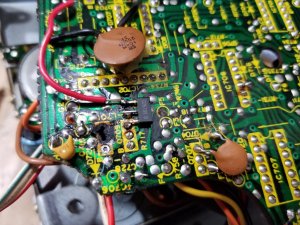The transistor, Q712, that is part of the 12V regulator on the tape deck PCB, runs quite hot. An infrared thermometer indicates 140+, and it is very hot to the touch. Any idea what I should expect there? Is this clearly way too hot?
To give some context; I've been working on this deck for quite a while (long story for another time). The box it came in had many things wrong with it, and I suspect it may have been overvolted. The tape deck alone had several things wrong it. FR703 was toast, FR704 toasty but still checking OK, Q710 was burnt, Q712 was shorted, the 7V regulator's zener was shorted, etc etc. The capstan motor also ran rough and I've replaced with a temp motor from another boomer. All belts have been replaced with their official sizes. Everything runs fine and stable now. The 12V itself looks nice and flat on a scope. Caps in its path have been replaced. The one thing I'm not sure of is whatever else is powered other than the capstan motor. Looks like in play mode it powers more stuff through S703 (switch in the mechanism).
Since someone else has been in here (a pcb's corner was broken for instance, though it didn't interrupt any traces luckily), I wonder if perhaps Q712 had a heatsink of some sorts that is now missing?
To give some context; I've been working on this deck for quite a while (long story for another time). The box it came in had many things wrong with it, and I suspect it may have been overvolted. The tape deck alone had several things wrong it. FR703 was toast, FR704 toasty but still checking OK, Q710 was burnt, Q712 was shorted, the 7V regulator's zener was shorted, etc etc. The capstan motor also ran rough and I've replaced with a temp motor from another boomer. All belts have been replaced with their official sizes. Everything runs fine and stable now. The 12V itself looks nice and flat on a scope. Caps in its path have been replaced. The one thing I'm not sure of is whatever else is powered other than the capstan motor. Looks like in play mode it powers more stuff through S703 (switch in the mechanism).
Since someone else has been in here (a pcb's corner was broken for instance, though it didn't interrupt any traces luckily), I wonder if perhaps Q712 had a heatsink of some sorts that is now missing?



